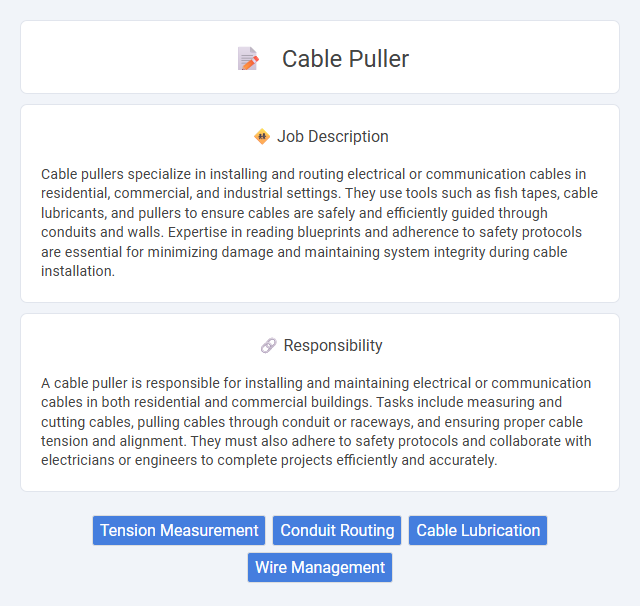
Cable pullers specialize in installing and routing electrical or communication cables in residential, commercial, and industrial settings. They use tools such as fish tapes, cable lubricants, and pullers to ensure cables are safely and efficiently guided through conduits and walls. Expertise in reading blueprints and adherence to safety protocols are essential for minimizing damage and maintaining system integrity during cable installation.
Individuals with strong physical stamina and good hand-eye coordination are likely to be suitable for cable puller jobs due to the demanding nature of pulling and installing cables in various environments. Those with pre-existing back or joint issues might face difficulties or increased risk of injury, making this role less appropriate for them. The job probably requires a willingness to work in potentially confined or outdoor spaces, which may not be ideal for people with claustrophobia or sensitivity to harsh weather conditions.
Qualification
Cable puller jobs require physical strength, manual dexterity, and the ability to work in confined spaces or at heights. Candidates typically need experience with electrical wiring, cable installation techniques, and safety protocols related to electrical systems. Certifications such as OSHA safety training and a basic understanding of electrical codes enhance qualifications for cable puller positions.
Responsibility
A cable puller is responsible for installing and maintaining electrical or communication cables in both residential and commercial buildings. Tasks include measuring and cutting cables, pulling cables through conduit or raceways, and ensuring proper cable tension and alignment. They must also adhere to safety protocols and collaborate with electricians or engineers to complete projects efficiently and accurately.
Benefit
A cable puller job likely offers significant physical activity, which may contribute to improved fitness and overall health. The role probably provides opportunities for hands-on skill development and experience with electrical systems, enhancing employability in the trade. Earning potential and job stability could be attractive benefits, especially in sectors with ongoing infrastructure projects.
Challenge
Cable puller jobs likely present significant physical and technical challenges due to the need to maneuver heavy cables in confined or elevated spaces. The tasks may require problem-solving skills to navigate obstacles and ensure proper cable placement without damage. These challenges could make the role demanding but potentially rewarding for those with strong endurance and attention to detail.
Career Advancement
Cable puller positions offer significant opportunities for career advancement into roles such as electrical technician, project supervisor, or site manager. Gaining expertise in cable installation, splicing, and safety protocols enhances employability within telecom, construction, and utility industries. Certifications like OSHA safety training and fiber optic splicing can accelerate progression to higher-paying, supervisory, or specialized technical roles.
Key Terms
Tension Measurement
Cable pullers specialize in the installation and maintenance of electrical cables, emphasizing precise tension measurement to prevent cable damage and ensure safety. Accurate tension assessment utilizes tension meters or load cells to monitor force applied during cable laying, minimizing risks of overstretching or snapping. Maintaining optimal tension extends cable lifespan, supports structural integrity, and enhances overall system reliability in power and communication networks.
Conduit Routing
Cable pullers specialize in conduit routing by expertly guiding electrical cables through pre-installed conduits in residential, commercial, and industrial settings. They ensure precise alignment and secure placement, minimizing cable damage and optimizing signal integrity during the pull. Mastery in using fish tapes, cable lubricants, and tension control techniques enhances efficiency and safety in conduit routing tasks.
Cable Lubrication
Cable pullers rely heavily on efficient cable lubrication to reduce friction during the installation of electrical or communication cables over long distances. Proper lubrication ensures smoother cable movement through conduit or ducts, minimizing the risk of damage and strain on both the cable and the puller's equipment. High-quality lubricants tailored for specific cable types and environmental conditions enhance operational efficiency and extend cable lifespan.
Wire Management
A cable puller specializes in installing, routing, and securing electrical wires and cables within buildings and infrastructure, ensuring organized wire management to prevent tangling and damage. Effective wire management enhances safety, facilitates maintenance, and improves system performance by reducing electrical interference and wear. Techniques include using cable trays, ties, conduits, and labeling systems to maintain clear pathways and proper separation of different cable types.
 kuljobs.com
kuljobs.com